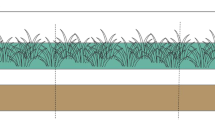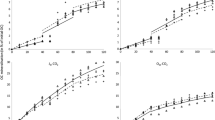Abstract
Several studies have pointed to the potential benefits of riparian vegetation as buffer zones for agricultural and industrial pollutants harmful to aquatic ecosystems. However, other studies have called into question its use as an ecological filter, questioning the widths and conditions for which they are effective as a filter. In this work, we have investigated the buffering capacity of the riparian one to retain pesticides in the water-saturated zone, on 27 sites composed by riparian buffer zones with different vegetation structure (woody, shrubs, or grass vegetation) and width (12, 36, and 60 m). Five pesticides were analyzed. The effectiveness of the filtering was largely influenced by the width and vegetation type of the buffer zone. In general, decreasing pesticide removal followed in this order wood > shrubs > grass. The 60 m woody buffer zone was the most effective in the removal of all the pesticides. Only atrazine was detected in this case (0.3 μg L−1). Furthermore, a linear correlation (R 2 > 0.97) was observed in their removal for all compounds and buffer zones studied. Thus, preserving the woody vegetation in the riparian zone is important for watershed management and groundwater quality in the no-tillage system in temperate climate.



Similar content being viewed by others
References
Agdi K, Bouaid A, Esteban AM, Hernando PF, Azmani A, Camara C (2000) Removal of atrazine and four organophosphorus pesticides from environmental waters by diatomaceous earth-remediation method. J Environ Monitor 2:420–423
Aguiar TR Jr, Rasera K, Parron LM, Brito AG, Ferreira MT (2014) Nutrient removal effectiveness by riparian buffer zones in rural temperate watersheds: the impact of no-till crops practices. AGR Water Manage 149:74–80
Boyd RA (2000) Herbicides and herbicide degradates in shallow groundwater and the Cedar River near a municipal well field, Cedar Rapids, Iowa. Sci Total Environ 248:241–253
Brazil (2011) Portaria n° 2914 de 12 de dezembro de 2011 do Ministério da Saúde. Dispõe sobre os procedimentos de controle e de vigilância da qualidade da água para consumo humano e seu padrão de potabilidade
Carabias-Martinez R, Rodriguez-Gonzalo E, Herrero-Hernandez E, Sanchez-San Roman FJ, Prado Flores MG (2002) Determination of herbicides and metabolites by solid-phase extraction and liquid chromatography—evaluation of pollution due to herbicides in surface and groundwaters. J Chromatogr A 950:157–166
Cerejeira MJ, Viana P, Batista S, Pereira T, Silva E, Valério MJ, Silva A, Ferreira M, Silva-Fernandes AM (2003) Pesticides in Portuguese surface and groundwaters. Water Res 37:1055–1063
Correia FV, Macrae A, Guilherme LRG, Langenbach T (2007) Atrazine sorption and fate in a Ultisol from humid tropical Brazil. Chemosphere 67:847–854
Correll DL (2005) Principles of planning and establishment of buffer zones. Ecol Eng 24:433–439
European Commission (2006) SANCO/10232/2006, Quality control procedures for pesticide residues analysis, European Union
Feakin SJ, Blackburn E, Burns RG (1994) Biodegradation of s-triazine herbicides at low concentrations in surface waters. Water Res 28:2289–2296
Foster S, Hirata R, Gomes D, D’edlia M, Paris M (2002) Groundwater quality protection: a guide for water utilities, municipal authorities, and environment agencies. Washington, The World Bank
Graymore M, Stagnitti F, Allinson G (2001) Impacts of atrazine in aquatic ecosystems. Environ Int 26:483–495
Grismer ME, O’Geen AT, Lewis D (2006) Vegetative filter strips for nonpoint source pollution control in agriculture. ANR Publ 8195:1–7
Inoue MH, Oliveira RS Jr, Regitano JB, Tormenta CA, Constantin J, Tornisielo VL (2006) Sorption-desorption of atrazine and diuron in soils from Southern Brazil. J Environ Sci Health B 41:605–621
Laabs V, Amelung W, Pinto A, Zech W (2002) Fate of pesticides in tropical soils of Brazil under field conditions. J Environ Qual 31:256–268
Lacorte S, Guiffard I, Fraisse D, Barcelo D (2000) Broad spectrum analysis of 109 priority compounds listed in the 76/464/CEE Council Directive using solid-phase extraction and GC/EI/MS. Anal Chem 72:1430–1440
Lovell ST, Sullivan YWC (2006) Environmental benefits of conservation buffers in the United States: evidence, promise, and open questions. Agr Ecosyst Environ 112:249–260
Mander U, Kuusemets V, Lohmus K, Mauring T (1997) Efficiency and dimensioning of riparian buffer zones in agricultural catchments. Ecol Eng 8:299–324
Putnam RA, Nelson JO, Clark JA (2003) The persistence and degradation of chlorothalonil and chlorpyfiros in a cranberry bog. J Agric Food Chem 51:170–176
Ramsey RJL, Stephenson GR, Hall JC (2005) A review of the effects of humidity, humectants, and surfactant composition on the absorption and efficacy of highly water-soluble herbicides. Pestic Biochem Physiol 82:162–175
Ritter WF (1990) Pesticide contamination of ground water in the United States—a review. J Environ Sci Health 25:1–29
Ruschel AR, Mantovani M, Reis MS, Nodari RO (2009) Caracterização e dinâmica de duas fases sucessionais em floresta secundária da Mata Atlántica. Rev Arvore 33:101–115
Six J, Feller C, Denef K, Ogle SM, Sá JCDM, Albrecht A (2002) Soil organic matter, biota and aggregation in temperate and tropical soils: effects of no-tillage. Agronomie 22:755–775
Syversen N (2002) Effect of a cold-climate buffer zone on minimising diffuse pollution from agriculture. Water Sci Technol 45:69–76
Tiwari MK, Guha S (2014) Kinetics of biotransformation chlorpyrifos in aqueous and soil slurry environments. Water Res 51:73–85
U.S. Environmental Protection Agency (EPA) (2003) Atrazine interim reregistration eligibility decision. http://www.epa.gov/oppsrrd1/REDs/atrazine_ired.pdf. Accessed 30 Sept 2014
Van Maanen JM, De Vaan MA, Veldstra AW, Hendry WP (2001) Pesticides and nitrate in groundwater and rainwater in the province of Limburg in The Netherlands. Environ Monit Assess 72:95–114
Acknowledgments
This work was supported by CNPq (National Counsel of Technological and Scientific Development-Brazil) and ServiAmbi Project (Assessment and valuation of environmental services in different land use systems) funded under the MP2 Programme-Embrapa (no. 0211010310001).
Conflict of interest
The authors declare no competing financial interest.
Author information
Authors and Affiliations
Corresponding author
Additional information
Responsible editor: Philippe Garrigues
Highlights
1. Widths and vegetation types were tested as buffer zone for pesticides from no-till agro-systems.
2. Woody vegetation showed a high efficiency for removal of atrazine, lambda-cyhalothrin, lactofen, fluazifop-p-butyl, and chlorpyrifos.
3. Grasses did not show a relevant removal efficiency for the studied pesticides.
4. The removal effectiveness was largely influenced by the width of the buffer zone and its vegetation type.
Rights and permissions
About this article
Cite this article
Aguiar, T.R., Bortolozo, F.R., Hansel, F.A. et al. Riparian buffer zones as pesticide filters of no-till crops. Environ Sci Pollut Res 22, 10618–10626 (2015). https://doi.org/10.1007/s11356-015-4281-5
Received:
Accepted:
Published:
Issue Date:
DOI: https://doi.org/10.1007/s11356-015-4281-5




